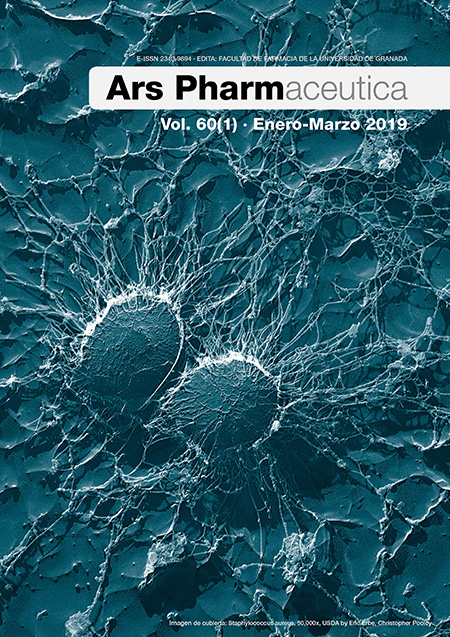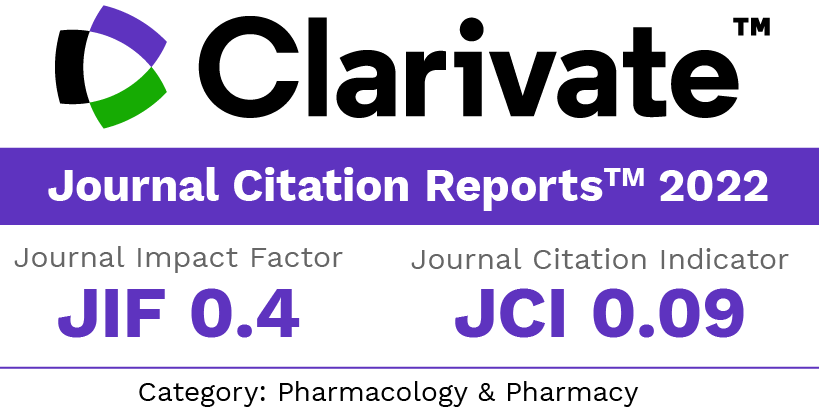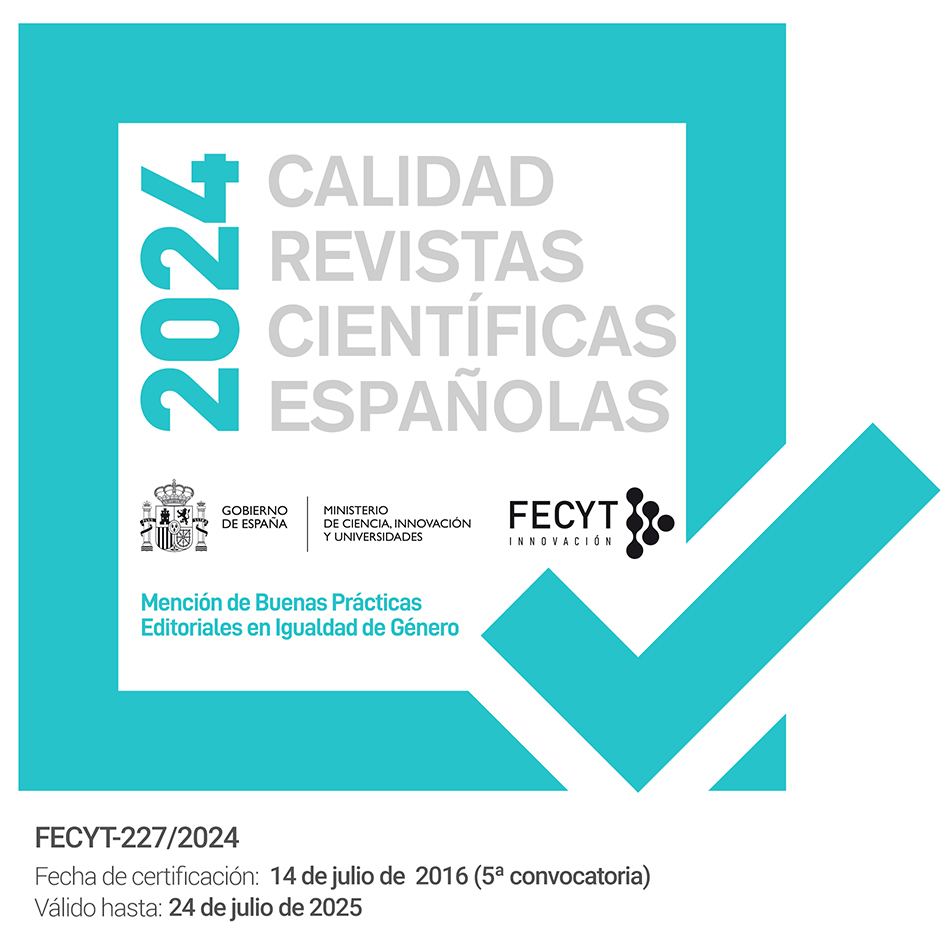International integration of the journals Ars Pharmaceutica
DOI:
https://doi.org/10.30827/ars.v60i1.8289Keywords:
Emerging Sources Citation Index, International integration, Ars Pharmaceutica, Citation analysisAbstract
Objectives: Ars Pharmaceutica has been indexed in the Emerging Sources Citation Index from Web of Science. This allows tracking the citation activity of the journal. The main contribution of this paper is to analyze quantitatively the citation patters of the journal.
Methods: In this study we use the citation metrics obtained from the SciELO database. To identify received citations we have retrieved all citing documents from Web of Science and processed the following data: publication year; journal; authors; countries; document type and language.
Results: The most cited journlas by Ars Pharmaceutica are positioned in the first quartile of the Journal Citation Reports, in the Pharmacology & Pharmacy category. Received citations, which are progressively increasing, belong mostly from journals indexed in the Pharmacology & Pharmacy; Chemistry and Food Science Technology categories, well positioned according to their Journal Impact Factors. Citing countries and institutions come mainly from Spain and India, which along with Brazil and Mexico, represent 56% of all citations. Citing documents are mostly research articles written in English language.
Conclusions: By analyzing cited documents from Ars Pharmaceutica we conclude that it is integrated on the consumption of international literature. Received citations reflect an international scope, although it still does not reach figures similar to other journals. The relation between authors, countries, institutions and language indicate that citations come from Spanish autors publishing in impact journals written in English. This model suggests that the consumption of published research is basically national, and does not reach the international sphere with the exception of Latin America and India. This isolation is still a pending challenge fro Spanish journals.
Downloads
References
Web of Science-Clarivate Analytics [internet] [citado octubre 2018]. Disponible en http://apps.webofknowledge.com/WOS_GeneralSearch_input.do;jsessionid=759622377A694D8568C1AE646338EB19?product=WOS&search_mode=GeneralSearch&SID=C4wnhZtS6bhU79brNak&preferencesSaved=
CNEAI [Internet]. España: Ministerio de Educación, Cultura y Deporte [citado octubre 2018]. Disponible en: http://www.mecd.gob.es/ministerio-mecd/organizacion/organismos/cneai.html
Ruiz-Pérez R, Delgado López-Cózar E, Jiménez Contreras E. Principios y criterios utilizados en España por la Comisión Nacional Evaluadora de la Actividad Investigadora (CNEAI) para la valoración de las publicaciones científicas: 1989-2009. Psicothema. 2010; 22(4):898-908
Web of Science-Clarivate Analytics: Incites Journal Citation Reports [internet] [citado octubre 2018] Disponible en: http://jcr.incites.thomsonreuters.com/JCRJournalHomeAction.action
Rodríguez-Yunta L. Revistas españolas en WoS. Anuario ThinkEPI. 2010; 4:250-253
Master Journal List-Clarivate Analytics: Arts & Humanities Citation Index [internet] [citado octubre 2018]. Disponible en: http://mjl.clarivate.com/cgi-bin/jrnlst/jloptions.cgi?PC=H
Master Journal List-Clarivate Analytics: Emerging Sources Citation Index [internet] [citado octubre 2018]. Disponible en: http://mjl.clarivate.com/cgi-bin/jrnlst/jloptions.cgi?PC=EX
ARS Pharmaceutica [internet] [citado octubre 2018]. Disponible en: http://revistaseug.ugr.es/index.php/ars/index
Web of Science-Clarivate Analytics: Web of Science Core Collection [internet] [citado octubre 2018]. Disponible en: https://apps.webofknowledge.com/Search.do?product=WOS&SID=D69B4O8GU1k8tJxmJOF&search_mode=GeneralSearch&prID=8fa1573f-32db-421c-b432-87eb2ce1e312
Repiso-Caballero R, Torres-Salinas D. Características e implicaciones de las bases de datos Emerging Sources Citation Index (Thomson Reuters): las revistas en estado transitorio. Anuario ThinkEPI. 2016; 10. doi: 10.3145/thinkepi.2016.46
Testa J. The Thomson Reuters Journal Selection Process [actualizado Julio 2016] [internet] [citado octubre 2018]. Disponible en: http://wokinfo.com/essays/journal-selection-process/
esta J. Journal Selection Process [actualizado Junio 2018] [internet] [citado octubre 2018]. Disponible en: https://clarivate.com/essays/journal-selection-process/
SciElo: Scientific Electronic Library Online [internet] [citado octubre 2018]. Disponible en: http://scielo.isciii.es/statjournal.php?lang=es&issn=2340-9894&collection=esp
Sanz-Valero J, Tomás-Gorriz V, Morales Suárez-Varela MM. Estudio bibliométrico de la producción científica publicada por la Revista Ars Pharmaceutica en el periodo 2001 a 2013. Ars Pharm. 2014; 55(2):1-10
Porcel Torrens A, Castellano Gómez M, Valderrama Zurián JC, Aleixandre Benavent R, Choren S. Análisis de citas en la revista Adicciones. Adicciones. 2003;15(4):309-319
Aleixandre Benavent R, Valderrama Zurián JC, Castellano Gómez N, Miguel-Dasit A, Simó Meléndez R, Navarro Molina C. Factor de impacto nacional e internacional de Revista Española de Cardiología. Rev Esp Cardiol. 2004; 57:1241. doi: 10.1157/13069872
Downloads
Published
How to Cite
Issue
Section
License
Copyright (c) 2019 Rafael Ruiz-Pérez, Carlos Ruiz-Fresneda

This work is licensed under a Creative Commons Attribution-NonCommercial-ShareAlike 4.0 International License.
The articles, which are published in this journal, are subject to the following terms in relation to the rights of patrimonial or exploitation:
- The authors will keep their copyright and guarantee to the journal the right of first publication of their work, which will be distributed with a Creative Commons BY-NC-SA 4.0 license that allows third parties to reuse the work whenever its author, quote the original source and do not make commercial use of it.
b. The authors may adopt other non-exclusive licensing agreements for the distribution of the published version of the work (e.g., deposit it in an institutional telematic file or publish it in a monographic volume) provided that the original source of its publication is indicated.
c. Authors are allowed and advised to disseminate their work through the Internet (e.g. in institutional repositories or on their website) before and during the submission process, which can produce interesting exchanges and increase citations of the published work. (See The effect of open access).























